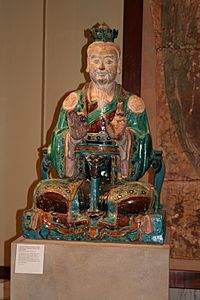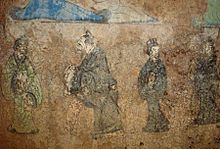Chinese philosophy facts for kids
Quick facts for kids Chinese philosophy |
|||||||||||||||||||||||||||||
|---|---|---|---|---|---|---|---|---|---|---|---|---|---|---|---|---|---|---|---|---|---|---|---|---|---|---|---|---|---|

Yin and Yang symbol with the bagua symbols paved in a clearing outside of Nanning City, Guangxi province, China
|
|||||||||||||||||||||||||||||
| Chinese name | |||||||||||||||||||||||||||||
| Traditional Chinese | 中國哲學 | ||||||||||||||||||||||||||||
| Simplified Chinese | 中国哲学 | ||||||||||||||||||||||||||||
|
|||||||||||||||||||||||||||||
| Vietnamese name | |||||||||||||||||||||||||||||
| Vietnamese | Triết học Trung Quốc | ||||||||||||||||||||||||||||
| Chữ Hán | 哲學中國 | ||||||||||||||||||||||||||||
| Korean name | |||||||||||||||||||||||||||||
| Hangul | 중국 철학 | ||||||||||||||||||||||||||||
| Hanja | 中國哲學 | ||||||||||||||||||||||||||||
|
|||||||||||||||||||||||||||||
| Japanese name | |||||||||||||||||||||||||||||
| Kanji | 中国哲学 | ||||||||||||||||||||||||||||
| Kana | ちゅうごくてつがく | ||||||||||||||||||||||||||||
|
|||||||||||||||||||||||||||||
Chinese philosophy started a long time ago in ancient China. It began during the Spring and Autumn period and the Warring States period. This time was special because many new ideas and ways of thinking appeared. People called it the "Hundred Schools of Thought".
Even though many ideas came from the Warring States period, some parts of Chinese philosophy are much older. You can find them in the I Ching, also known as the Book of Changes. This ancient book is about divination and is thousands of years old. During the Warring States era, three main types of philosophy became very important. These were Confucianism, Legalism, and Taoism. Other ideas, like Mohism and Chinese Naturalism, were also around but became less known later. Even today, Confucianism still guides how many Chinese people act and behave.
Contents
Ancient Chinese Ideas: How Did They Start?
Early ideas in the Shang dynasty were all about cycles. Think about how day and night repeat, or how seasons come back every year. The moon also grows and shrinks in a cycle. People in the Shang dynasty saw these patterns in nature. This idea of cycles and order stayed important throughout Chinese history. It's different from how many Western thinkers see time, which is often seen as a straight line moving forward.
During the Shang dynasty, people also honored their ancestors. This was a widely accepted belief. When the Zhou took over from the Shang, they brought a new idea called the Mandate of Heaven. This idea said that rulers were allowed to rule only if they were good and fair. If a ruler became bad, they would lose the Mandate of Heaven. This justified the Zhou's rule. Some early ideas might also be found in very old Chinese books, though their exact origins are debated.
Main Types of Chinese Philosophy
Confucianism: Rules for a Good Society
Confucianism grew from the teachings of a wise man named Confucius (551–479 BCE). He wanted to share the good values from the earlier Zhou period. His ideas are mostly about how people should act and how governments should work. He stressed being moral, treating others well, being fair, and being honest.
Confucius's teachings are found in a book called The Analects. He taught that rituals and good manners are important. He also emphasized 'ren', which means being kind and humane. Confucianism, along with Legalism, helped create the world's first meritocracy. This means that a person's position in society should be based on their education and character, not on their family, money, or friends. Confucianism has had a huge impact on Chinese culture and all of East Asia.
Before the Han dynasty, Confucianism had big rivals like Chinese Legalism and Mohism. But during the early Han dynasty, Confucianism became the main way of thinking. Legalism became less popular because it was linked to the strict rule of Qin Shi Huang. However, many of its ideas still influenced Chinese thought later on. Mohism, which focused on universal love, also faded as Confucian ideas became stronger.
Later, during the Six Dynasties era, Buddhism came to China from India. It grew and changed over time, becoming a truly Chinese philosophy, especially the Zen Buddhism school. Neo-Confucianism became very popular during the Song dynasty and Ming dynasty. It mixed ideas from Confucianism, Buddhism, and even Taoism.
In more recent times (19th and 20th centuries), Chinese philosophy started to include ideas from Western philosophy. People wanted to modernize China. They tried to bring in ideas like democracy, Marxism, and socialism. Famous examples include Sun Yat-Sen's "Three Principles of the People" and Mao Zedong's "Maoism". Today, the official idea in China is "market economy socialism". Even with these new ideas, ancient Chinese philosophy still deeply influences Chinese culture.
Taoism: Finding Harmony with Nature

Taoism began as a philosophy and later became a religion. Its main texts are the Tao Te Ching (written by Lao Tzu) and the Zhuangzi. The word Dao means 'path' or 'way'. In Taoism, it refers to a powerful, unseen force that guides the whole universe. This force cannot be fully described or felt.
Taoism teaches about non-action (wu wei), which means not forcing things. It also values softness, being spontaneous, and seeing things from different angles. Taoism often seems to be the opposite of Confucianism, which focuses on active morality. However, many Chinese people would "practice Confucianism on the outside, Taoism on the inside." This means they follow social rules but also seek inner peace.
Taoism's main idea is that human attempts to make the world better often make it worse. So, it's better to aim for harmony. This means trying not to interfere too much with nature or with how human affairs naturally unfold.
Legalism: Strict Laws for Order
Legalism was a philosophy that believed in strong laws and strict punishments. A philosopher named Han Fei brought together many of these ideas. Legalists believed that when times change, the rules must also change. They thought rulers should govern using three main things:
- Fa (法): Clear laws or principles.
- Shu (術): Methods, tactics, or ways of governing.
- Shi (勢): Power or authority.
Legalism was very different from Confucianism and Mohism. It was used by the Qin dynasty, which was known for its very strict and controlling rule. Because of this, Legalism later became unpopular. Its main motto was: "Set clear strict laws, or deliver harsh punishment." Legalists believed that rulers should have full power over rewards and penalties, enforced through law. They thought everyone should follow the law strictly, no matter what.
Naturalists: Understanding Nature's Forces
The School of Naturalists (also called the School of Yin-yang) was a philosophy from the Warring States period. It combined the ideas of yin-yang and the Wu Xing (Five Elements). Zou Yan is seen as the founder of this school. His theory tried to explain the universe using basic forces in nature. These forces are:
- Yin (dark, cold, female, negative)
- Yang (light, hot, male, positive)
- The Five Elements (water, fire, wood, metal, and earth).
These ideas became important in Chinese philosophy and everyday beliefs. This school's ideas were later mixed into Taoism and Chinese medicine.
Mohism: Universal Love for Everyone
Mohism was founded by Mozi (墨子). It promoted the idea of universal love for everyone. Mozi believed that if everyone loved each other equally, there would be no conflict or war. He disagreed with Confucian rituals. Instead, he focused on practical ways to survive, like farming and building strong defenses.
Mozi thought that traditions could be confusing. He believed people needed a clear guide to know which traditions were good. This guide should encourage actions that benefit everyone. Mozi linked his ideas to the "Will of Heaven," but his philosophy was more like utilitarianism. This means it focused on what brings the greatest good to the greatest number of people.
Logicians: The Power of Words and Logic
The Logicians (also called the School of Names) were interested in logic, paradoxes, and how words relate to reality. They were similar to the Confucian idea of "rectification of names." A logician named Hui Shi was a friendly rival to Zhuangzi. He would playfully argue against Taoist ideas. Another logician, Gongsun Long, created the famous dialogue "When a White Horse is Not a Horse." This dialogue explored tricky ideas about names and what things truly are.
Agriculturalists: Simple Life and Farming
Agriculturalism was an early social and political philosophy. It supported a simple, farming-based community where everyone was equal. This philosophy believed that human society started with farming. It thought societies should be based on people's natural desire to farm.
Agriculturalists believed the best government was led by a kind king. This king would work in the fields alongside his people. He wouldn't be paid by the government. Instead, he would earn his living from farming, just like everyone else. Unlike Confucians, Agriculturalists didn't believe in the division of labour. They argued that a country's economy should be based on everyone being able to support themselves. They also supported fixed prices, where all similar goods had the same price, no matter their quality or demand.
Philosophy in Imperial China
Qin and Han Dynasties: Legalism to Confucianism
The short-lived Qin dynasty made Legalism its official philosophy. It even tried to suppress Mohist and Confucian schools. Legalism remained important during the early Han dynasty. However, Emperor Wu of Han later made Confucianism the official way of thinking. Confucianism and Taoism then became the main forces in Chinese thought until Buddhism arrived.
Confucianism was very strong during the Han dynasty. A key thinker was Dong Zhongshu. He combined Confucianism with other ideas, including the Five Elements theory. He also promoted the New Text school, which saw Confucius as a divine figure. In contrast, the Old Text school believed Confucius was a great wise man, but still human.
Six Dynasties: Rise of Xuanxue and Buddhism
The 3rd and 4th centuries saw the rise of Xuanxue (mysterious learning), also called Neo-Taoism. This school mixed ideas from Confucianism and Taoism. It reinterpreted important texts like the I Ching, Tao Te Ching, and Zhuangzi. Key philosophers of this movement included Wang Bi and Guo Xiang. They explored questions about existence.
Buddhism came to China around the 1st century AD. But it only became very influential during the Northern and Southern, Sui, and Tang dynasties. At first, people thought it was a type of Taoist group. Mahayana Buddhism became much more popular in China than Hinayana. Both Indian and local Chinese Buddhist schools developed. The Chan sect was especially important, and it had a big impact in Japan as the Zen sect.
By the mid-Tang dynasty, Buddhism was at its peak. However, Confucian scholars criticized it, seeing it as a foreign religion. In 845, Emperor Wuzong ordered a major crackdown on Buddhism. Monasteries were closed, and monks and nuns had to return to normal life. After this, Buddhism lost much of its power.
Neo-Confucianism: A New Look at Old Ideas
Neo-Confucianism was a new version of old Confucian principles. It appeared around the Song dynasty and included ideas from Buddhism, Taoism, and even Legalism. Early Neo-Confucian philosophers like Zhou Dunyi were interested in how the universe works.
The Cheng brothers, Cheng Yi and Cheng Hao, are seen as the founders of the two main schools of Neo-Confucianism: the School of Principle and the School of Mind. The School of Principle became very important during the Song dynasty, especially with the ideas of Zhu Xi. His system was officially used for government exams. The School of Mind, developed by Lu Jiuyuan, was later revived by Wang Shouren during the Ming dynasty. His influence was as great as Zhu Xi's. This school was also very important in Japan.
-
Zhu Xi was a leading figure in Neo-Confucianism.
-
Wang Yangming was an important figure in Neo-Confucianism.
During the Qing dynasty, many philosophers disagreed with Neo-Confucianism. They went back to the ideas of Han dynasty Confucianism. Western culture also started to enter China. Many Chinese thinkers believed that while Westerners might be better at technology, China was superior in moral and intellectual matters. Chinese philosophy also greatly influenced the ideas in Korean philosophy, Vietnamese philosophy, and Japanese philosophy.
Modern Chinese Philosophy
In the modern age, Chinese philosophy began to mix with ideas from Western philosophy. This was part of China's efforts to modernize. Before this, Chinese philosophy did not have a concept like "human rights". So, a new word, quanli (Chinese: 權利), had to be created to translate the Western idea of "rights."
By the time of the Xinhai Revolution in 1911, many people wanted to get rid of China's old imperial ways. There were attempts to bring ideas like democracy and republicanism into Chinese philosophy. Sun Yat-Sen was a key figure in this. Mao Zedong later added Marxism and other communist ideas.
When the Chinese Communist Party took power, many older schools of thought were criticized. Some were even suppressed during the Cultural Revolution. However, their influences still remain in Chinese thought today. The current government of the People's Republic of China is trying to encourage a form of market socialism.
After the Cultural Revolution, the Chinese government became more open to traditional beliefs. The 1978 Constitution of the People's Republic of China allows "freedom of religion" with some limits. Spiritual and philosophical groups are allowed to exist again, as long as they don't threaten the power of the CPC. These groups are still closely watched. The ideas from China's past are still deeply rooted in its culture.
New Confucianism: A Modern Revival
New Confucianism is a modern movement of Confucianism. It started in the early 20th century and was revived after the Mao era. It is influenced by the Neo-Confucianism of the Song and Ming dynasties, but it is not exactly the same. It tries to adapt Confucian ideas to the modern world.
Important Chinese Philosophers
- Confucius: Seen as the Great Master, though sometimes joked about by Taoists.
- Mencius: A follower of Confucius, focused on idealist ideas.
- Xun Zi: Another follower of Confucius, more realistic, and a teacher of Han Fei.
- Zhu Xi: A key founder of Neo-Confucianism.
- Wang Yangming: A very important supporter of the "state of mind" school.
- Lao Tzu: The main figure of the Taoist school.
- Chuang Tzu: Said to have written the Zhuangzi.
- Liezi: Said to have written the Liezi.
- Mozi: The founder of the Mohist school.
- Shang Yang: A Legalist founder and important reformer in the Qin state.
- Han Fei: One of the most famous thinkers of Legalism.
- Li Si: A major supporter and user of Legalism.
Key Ideas in Chinese Philosophy
Even though different Chinese philosophical schools have different ideas, they share some common words and concerns.
Here are some common terms:
- Dao (道): Means 'the Way' or a person's teachings.
- De (德): Means 'virtue' or 'power'.
- Li (理): Means 'principle' or 'law'.
- Qi (氣): Means 'vital energy' or 'material force'.
- Tai-chi (太極): The 'Great Ultimate'. It brings together the two opposite but complementary forces, Yin and Yang.
- Yin: Originally referred to the shady side of a hill. It represents the dark, passive, female principle.
- Yang: Originally referred to the sunny side of a hill. It represents the bright, active, male principle.
Yin and Yang are not enemies. They change in relation to each other, like the rise and fall of a wave. They are understood by comparing them.
Here are some common ideas found in Chinese philosophies:
- People are usually seen as part of nature, not separate from it.
- Questions about a single God, which are very important in Western philosophy, were not as central or a source of conflict in Chinese traditional beliefs.
- The main goal of philosophy is to be a guide for how to live a good and practical life.
- Many scholars of the Hundred Schools of Thought tried to convince rulers to govern in the way they believed was best.
Images for kids
-
Yin and Yang symbol with the bagua symbols paved in a clearing outside of Nanning City, Guangxi province, China
-
A Western Han (202 BC – 9 AD) fresco depicting Confucius, from a tomb of Dongping County, Shandong province, China
-
A Western Han (202 BC – 9 AD) fresco depicting Laozi, from a tomb of Dongping County, Shandong province, China
-
Zhu Xi was a leading figure in Neo-Confucianism.
-
Wang Yangming was an important figure in Neo-Confucianism.
See also
 In Spanish: Filosofía china para niños
In Spanish: Filosofía china para niños










